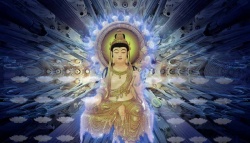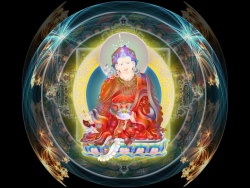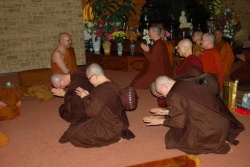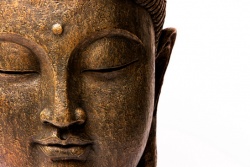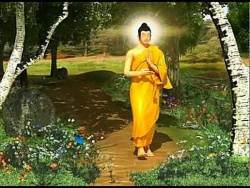Sangharaja
(Pali sangharaja); Supreme Patriarch;
Supreme Patriarch redirects here. For information on the patriarchs of the Western religions,
see Patriarch. For information on the Supreme Patriarch of Armenia, see Catholicos of Armenia.
Sangharaja (Pāli: sangha religious community + raja ruler, king, or {
{Wiki|prince}}) is the title given in many Theravada Buddhist countries to a senior monk who is the titular head either of a monastic fraternity (nikaya), or of the Sangha throughout the country.
This term is often rendered in English as 'Patriarch' or 'Supreme Patriarch'.
Overview
The position of sangharaja has been assigned according to various methods in different countries and time periods.
In some cases, the sangharaja is determined by absolute monastic seniority; the sangharaja is the monk who has spent the most rains retreats (vassa) as a monk.
In other cases, royal appointment may play a role- the sangharaja may be appointed by the king, particularly in Southeast Asian countries where the monarchy is closely associated with Buddhism (Thailand, for example).
Alternatively, the sangharaja may be chosen semi-democratically by monks or the laity (similar to the election of an abbot in some Theravada communities).
The authority and responsibility assigned to the sangharaja can also vary significantly. Traditionally, Buddhist monasticism has not imposed any particular obligation of obedience on Buddhist monks.
Any monk can offer criticism of any other monk with regards to violations of disciplinary rules, and a monk is not bound to follow the orders or recommendations of another monk - even a senior monk.
While in practice, the respect accorded to a senior monk and the standards of the local community often provide a significant impetus for requests from senior monks to be obeyed, there is no traditional or scriptural demand for such attitudes.
Most monasteries – even in areas where a sangharaja has been appointed – remain primarily self-governing or, at the most, dependent on a single larger temple in the same region.
As such, in some cases the sangharaja is primarily a figurehead, a focal point and spokesman for Buddhist piety, but not endowed with any particular authority.
Even without any clearly designated authority or responsibilities, a sangharaja can often effect significant changes in a Theravada country by employing the respect accorded to him and his office to mobilize monks and laymen for social or religious change.
Preah Maha Ghosananda of Cambodia was an example of this type of sangharaja – one whose influence over the local religious community far exceeded any ecclesiastic authority that he may have wielded.
In other cases, the sangharaja may be part of a national or regional hierarchy that is responsible for settling issues of wider importance to the national sangha.
The Supreme Patriarch of Thailand operates in this mold, in association with the civil government.
The central religious hierarchy is responsible for issues of national and regional importance- such as the curriculum of monastic schools, the creation of authoritative forms for scriptures and rituals,
and reform issues of nation-wide importance – leaving most local decisions to the discretion of individual temples and abbots (such as the ordination and disciplining of individual monks).
Sangharaja in Burma
In pre-colonial Burma, the office of Sangharaja was known as the Thathanabaing (သာသနာပိုင်, literally 'Keeper of the Sāsana') or formally Mahasangharaja (မဟာသံဃာရာဇာ), typically rendered into English as 'Primate', 'Archbishop' or 'Supreme Patriarch.'
The office, in its last incarnation, was established by King Bodawpaya in 1784, after the constitution of the Sudhamma Council, a council of four elder monks (thera), of which the Thathanabaing was its head.
Subsequent monarchs expanded the Council, which varied from 8 to 12 members called sadaw.
Council members were appointed by the king and styled Dazeitya Sayada (တံဆိပ်ရဆရာတော်, 'Teachers Possessing the Seal').[3]
The Thathanabaing was appointed by the king and granted supreme authority with regard to religious doctrine and ecclesiastical administration.
The Thathanapaing was responsible for the kingdom's religious affairs, including appointment of monastery abbots, monk orders according to the Vinaya,
management of breaches of discipline, preparation of an annual report of the order, and administration of Pali examinations.
The Thathanabaing was charged with managing the functions of two government officials, the Mahadan Wun (မဟာဒါန်ဝန်, Ecclesiastical Censor), who oversaw the king's charitable functions, ensured monk compliance with the Vinaya, and submitted registers of all active novices and monks,
and the Wutmye Wun (ဝတ်မြေဝန်), who managed the wuttakan (ဝတ္ထုကံမြေ), religious properties, including donated land and pagodas.
The Burmese kingdom was divided into ecclesiastical jurisdictions, each of which was overseen by a gaing-gyok. Underneath each gaing-gyok was a number of gaing-ok, who were in turn assisted by a number of gaing-dauk.
Ecclesiastical disputes were settled by the gaing-gyok and decisions for appeal were made by the Suddhama Council.
In 1895, soon after the abdication of the country's last king, Thibaw Min, the Taungdaw Sayadaw , then the Thathanapaing of Burma, died.
A subsequent election elected the Pakhan Sayadaw as Thathanabaing-elect, although the British refused to acknowledge or recognize his title.
In 1903, the lieutenant-governor of British Burma, Hugh Shakespear Barnes, reinstated the title by sanad charter, giving the Thathanapaing nominal authority over internal administration of the Sangha in Upper Burma and over Buddhist ecclesiastical law. (Lower Burma, which had been annexed in 1852, remained without a religious head.
The Taunggwin Sayadaw was appointed, but the position was abolished after his death and no successor was ever appointed.
Sangharaja in Cambodia
Main article: Supreme Patriarch of Cambodia
In Cambodia and the former Khmer kingdoms, the sangharaja (Khmer: សង្ឃរាជ sanghreach) was a senior monk appointed by the king who headed one of the countries monastic fraternities.
From the period between 1855 and the beginning of the Khmer era, one sangharaja existed for the Cambodian branch of the Dhammayuttika Nikaya, and another for the Maha Nikaya.
Because the Dhammayuttika order enjoyed closer ties to the throne, it officially had primacy in Cambodia, despite constituting a small majority of Khmer monks.
During the Khmer period, the role of sangharaja essentially vanished, as Buddhism was officially suppressed first by the Khmer Rouge and then by the Vietnamese backed People's Republic of Kampuchea.
In the late 70's, the PRK began to reverse its stance in order to gain wider popular support for its rule.
As part of this effort, a new sangharaja was appointed by the government in 1981 (Venerable Tep Vong), with both nikayas being combined into a single unified order.
In 1991 King Sihanouk, having returned from exile, appointed Bour Kry sangharaja of the Dhammayuttika order, returning Cambodia to the two-patriarch system.
As the monarchy no longer has government status in Cambodia, the two fraternities are now officially equals.
The full official title of the [Supreme Patriarch)] of the Maha Nikaya is Samdech Preah Sumedhādhipati, while the full official title of the Supreme Patriarch of the Dhammayuttika Nikaya is Samdech Preah Sugandhādhipati.
Sangharaja in Thailand, (Sangkharat)
Main article: Supreme Patriarch of Thailand
The Sangharaja (Thai: พระสังฆราช; RTGS: Sangkharat) of Thailand is traditionally appointed by the king, Rama I having appointed the first of modern times in 1782.
Since passage of the Sangha Act of 1902 in the reign of Rama V, the office has tended to alternate between ordained monks of the majority order of Maha Nikaya, and of the minority order of Dhammayuttika Nikaya.
The latter began as a reform movement within the larger order, established by Prince Mongkut, while he was an abbot with the ordination name of Vajirañāṇo, before ascending the throne as Rama IV.
Modern sangharajas
Somdet Phra Nyanasamvara (Charoen Suvaddhano), current sangharaja of Thailand
Preah Maha Ghosananda, (Maha Nikaya) the late sangharaja of Cambodia
Samdech Preah Sugandhādhipati Bour Kry)], current sangharaja of the Dhammayuttika Nikaya of Cambodia
Samdech Preah Sumedhādhipati Non Nget, current sangharaja of the Maha Nikaya of Cambodia
Samdech Preah Agga Mahā Sangharājādhipati Tep Vong, current agga sangharaja of Cambodia
In 1988, Maha Ghosananda was elected Supreme Patriarch by a group of exiled monks in Paris, however this status was not officially recognized in Cambodia. During this same period,
Tep Vong held the same office in the unified Cambodian sangha, and after 1991 as the Supreme Patriarch of the Maha Nikaya.
See also
Supreme Patriarch of Thailand
Supreme Patriarch of Cambodia
